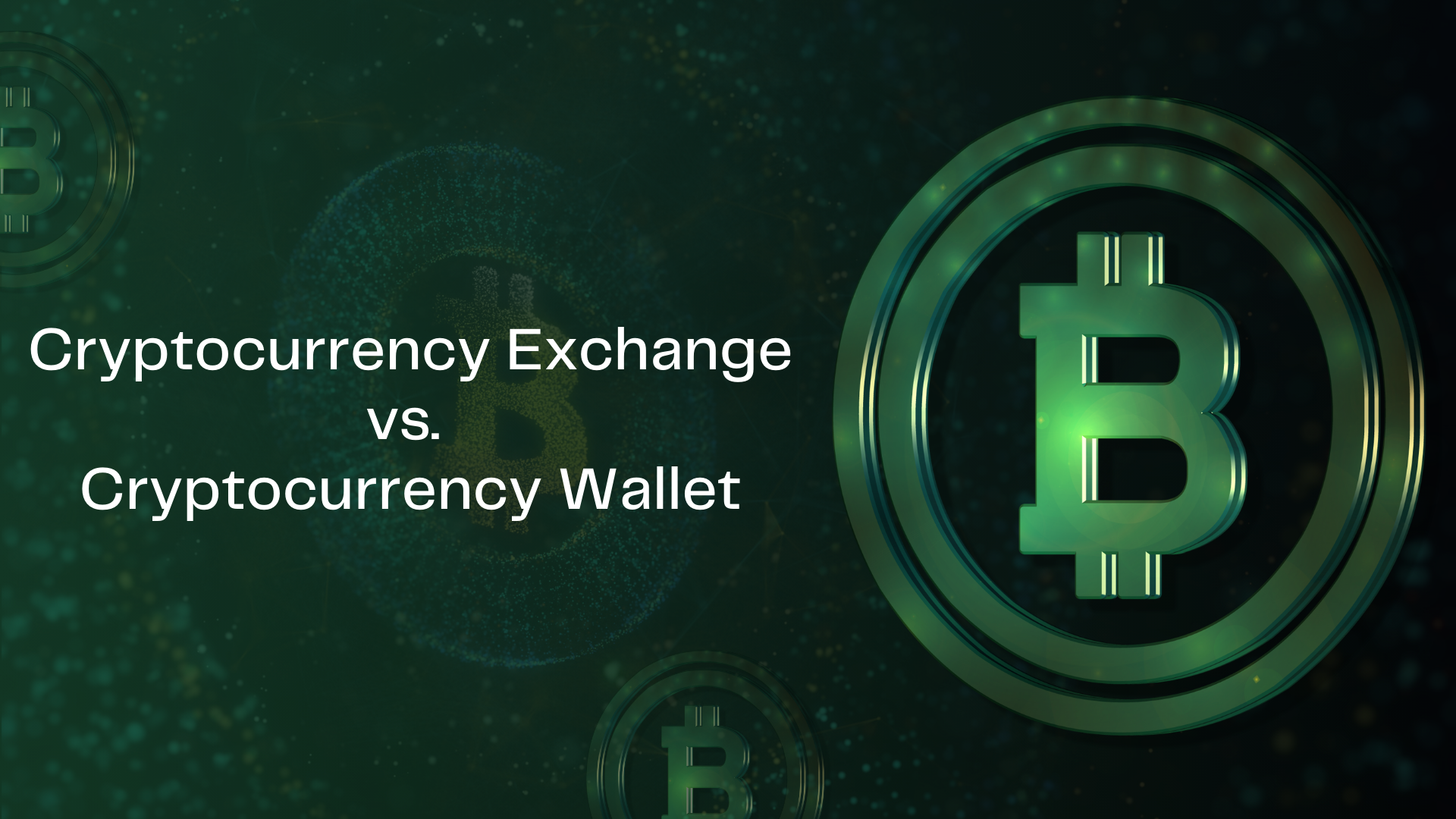With over 560 million cryptocurrency users worldwide in 2024, managing digital assets securely is more important than ever. But should you store your crypto in a wallet or trade on an exchange? Let us help you make smarter financial decisions.

Table of contents:
- Introduction
- What is a cryptocurrency exchange?
- What is a cryptocurrency wallet?
- Comparison chart: Crypto exchange vs. crypto wallet
- Key Differences Between a Crypto Exchange and a Crypto Wallet
- Choosing between a crypto exchange and a crypto wallet
- Final thoughts
As of 2024, global cryptocurrency ownership has reached an estimated 6.8% of the population, equating to over 560 million users worldwide. This surge in adoption underscores the importance of understanding the tools available for managing digital assets. Central to this are cryptocurrency exchanges and wallets, each serving unique functions within the crypto ecosystem.
The increasing adoption of cryptocurrencies has led to the development of various tools that facilitate transactions and storage. Among them, cryptocurrency exchanges and cryptocurrency wallets play significant roles in digital asset management. While both are essential components of the crypto ecosystem, they serve different purposes.
This article explores the differences between a crypto exchange and a crypto wallet, helping users understand their functions, advantages, and limitations.
What is a cryptocurrency exchange?
A cryptocurrency exchange is a platform that allows users to buy, sell, and trade cryptocurrencies. These platforms act as intermediaries, facilitating transactions between buyers and sellers. Cryptocurrency exchanges can be centralised or decentralised, each with its own set of features and security measures.
Types of cryptocurrency exchanges
- Centralised Exchanges (CEXs): These are the most common type of cryptocurrency exchanges. They are operated by a central authority or company, which manages the platform, holds users’ funds, and ensures the smooth execution of trades. Examples of popular centralised exchanges include Binance, Coinbase, and Kraken. Centralised exchanges are known for their user-friendly interfaces, high liquidity, and a wide range of supported cryptocurrencies.
- Decentralised Exchanges (DEXs): Unlike centralised exchanges, decentralised exchanges operate without a central authority. They use smart contracts and blockchain technology to facilitate peer-to-peer transactions. Users retain control of their private keys and funds, which enhances security and privacy. Examples of decentralised exchanges include Uniswap and SushiSwap. DEXs are often preferred by users who prioritise decentralisation and security over convenience.
Key features of crypto exchange
- Trading and liquidity: Crypto exchanges provide a marketplace for buying and selling digital assets.
- Price discovery: Prices of cryptocurrencies fluctuate based on supply and demand within the exchange.
- Security features: Exchanges implement measures like two-factor authentication (2FA) and cold storage to secure user funds.
- Regulation and compliance: Centralised exchanges comply with regulatory requirements, while decentralised exchanges operate without direct oversight.
What is a cryptocurrency wallet?
A cryptocurrency wallet is a digital tool that allows users to store, send, and receive cryptocurrencies. Unlike a cryptocurrency exchange, a wallet does not facilitate trading. Instead, it provides a secure place to store your digital assets. Cryptocurrency wallets come in various forms, each with its own set of features and security measures.
Types of crypto wallet
- Hot Wallets: These are online wallets that are connected to the internet. They are convenient for frequent transactions but are more vulnerable to hacking and cyber-attacks. Examples of hot wallets include mobile wallets like Trust Wallet and web wallets like MetaMask.
- Cold Wallets: These are offline wallets that are not connected to the internet. They offer a higher level of security and are ideal for long-term storage of cryptocurrencies. Examples of cold wallets include hardware wallets like Ledger and Trezor, as well as paper wallets.
- Software Wallets: These are applications that run on desktops or mobile devices. They provide users with access to their cryptocurrency holdings while maintaining control over private keys. Examples of software wallets include Exodus, Electrum, and Mycelium.
- Hardware Wallets: These are physical devices designed to store cryptocurrencies securely. They keep private keys offline, making them less susceptible to cyber threats. Examples of hardware wallets include Ledger and Trezor.
Key features of a crypto wallet
- Storage of digital assets: Wallets store private and public keys required for transactions.
- Security and privacy: Users have full control over their funds without third-party involvement.
- Facilitating transactions: Wallets allow users to send and receive cryptocurrencies directly.
Comparison chart: Crypto exchange vs. crypto wallet
| Feature | Crypto Exchange | Crypto Wallet |
| Primary Function | Facilitates trading and exchange of cryptocurrencies. | Stores cryptocurrencies securely and allows direct transactions. |
| Control Over Funds | Users rely on the exchange to store funds (CEXs). | Users have full control over their assets. |
| Security | Centralised exchanges pose a higher risk of hacking. DEXs are more secure but require self-custody. | Cold wallets offer better security as they are offline. |
| Convenience | High convenience for buying and selling assets. | Requires secure management of private keys. |
| Types | Centralised (CEX) and Decentralised (DEX). | Hot wallets, cold wallets, software wallets, hardware wallets. |
| Risk Factor | Prone to cyberattacks and regulatory interventions. | Risk of losing private keys or access credentials. |
| Access to Liquidity | Offers high liquidity and real-time trading options. | No liquidity feature; only facilitates transactions. |
Key Differences Between a Crypto Exchange and a Crypto Wallet
While both cryptocurrency exchanges and wallets are essential for managing digital assets, they serve different purposes and offer distinct features. Here are the key differences between the two:
- Purpose and Functionality:
- Cryptocurrency Exchange: The primary purpose of a cryptocurrency exchange is to facilitate the buying, selling, and trading of cryptocurrencies. Exchanges provide a platform where users can exchange one cryptocurrency for another or convert fiat currency (such as GBP or USD) into cryptocurrency. They offer various trading pairs, order types, and tools for market analysis.
- Cryptocurrency Wallet: The primary purpose of a cryptocurrency wallet is to store and manage digital assets. Wallets allow users to send and receive cryptocurrencies, view their balance, and manage their private keys. They do not facilitate trading or provide access to market data.
- Control Over Funds:
- Cryptocurrency Exchange: When you use a centralised exchange, you do not have full control over your funds. The exchange holds your private keys and manages your assets on your behalf. This means that if the exchange is hacked or goes out of business, you could lose your funds. Decentralised exchanges offer more control, as they allow users to retain custody of their private keys.
- Cryptocurrency Wallet: With a cryptocurrency wallet, you have full control over your funds. You hold your private keys and are responsible for the security of your assets. This gives you greater autonomy and reduces the risk of losing your funds due to exchange-related issues.
- Security:
- Cryptocurrency Exchange: Centralised exchanges are often targeted by hackers due to the large amounts of funds they hold. While reputable exchanges implement robust security measures, they are still vulnerable to cyber-attacks. Decentralised exchanges offer better security, as they do not hold users’ funds and rely on blockchain technology for transactions.
- Cryptocurrency Wallet: The security of a cryptocurrency wallet depends on its type. Hot wallets are more vulnerable to hacking, while cold wallets offer a higher level of security. Hardware wallets, in particular, are considered one of the safest options for storing cryptocurrencies.
- User Experience:
- Cryptocurrency Exchange: Exchanges are designed to be user-friendly, with intuitive interfaces and a wide range of features. They cater to both beginners and experienced traders, offering tools for market analysis, trading strategies, and portfolio management. However, the complexity of some exchanges can be overwhelming for new users.
- Cryptocurrency Wallet: Wallets are generally simpler in design and functionality. They focus on providing a secure and easy way to store and manage cryptocurrencies. While some wallets offer additional features, such as integration with decentralised applications (dApps), their primary purpose is to facilitate transactions and asset management.
- Accessibility:
- Cryptocurrency Exchange: Exchanges are accessible via web browsers and mobile apps, making it easy to trade cryptocurrencies on the go. However, some exchanges may have restrictions based on geographic location or require identity verification (KYC) to access certain features.
- Cryptocurrency Wallet: Wallets are also accessible via web browsers, mobile apps, and hardware devices. They offer greater flexibility in terms of accessibility, as they do not require identity verification or geographic restrictions. However, the security of your wallet depends on how you manage your private keys and backup phrases.
Choosing between a crypto exchange and a crypto wallet
The choice between a cryptocurrency exchange and a cryptocurrency wallet depends on your needs and goals. If you are looking to trade cryptocurrencies, an exchange is the appropriate tool. It provides the necessary platform and tools for buying, selling, and trading digital assets. However, if your primary goal is to store and manage your cryptocurrencies securely, a wallet is the better option.
In many cases, users will need both a cryptocurrency exchange and a wallet. For example, you might use an exchange to buy Bitcoin and then transfer it to a wallet for long-term storage. This approach allows you to take advantage of the features offered by both platforms while minimising risks.
Final thoughts
Cryptocurrency exchanges and cryptocurrency wallets are both essential tools in the digital asset ecosystem, but they serve different purposes. An exchange is a platform for buying, selling, and trading cryptocurrencies, while a wallet is a secure place to store and manage your digital assets. Understanding the differences between the two is crucial for making informed decisions and ensuring the security of your funds.
Whether you are a seasoned trader or a newcomer to the world of cryptocurrencies, it is important to choose the right tools for your needs. By using a combination of a reputable cryptocurrency exchange and a secure wallet, you can navigate the digital asset landscape with confidence and peace of mind.

Pallavi Singal is the Vice President of Content at ztudium, where she leads innovative content strategies and oversees the development of high-impact editorial initiatives. With a strong background in digital media and a passion for storytelling, Pallavi plays a pivotal role in scaling the content operations for ztudium’s platforms, including Businessabc, Citiesabc, and IntelligentHQ, Wisdomia.ai, MStores, and many others. Her expertise spans content creation, SEO, and digital marketing, driving engagement and growth across multiple channels. Pallavi’s work is characterised by a keen insight into emerging trends in business, technologies like AI, blockchain, metaverse and others, and society, making her a trusted voice in the industry.


































